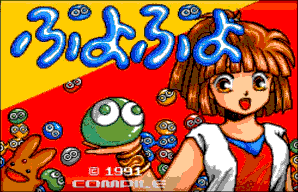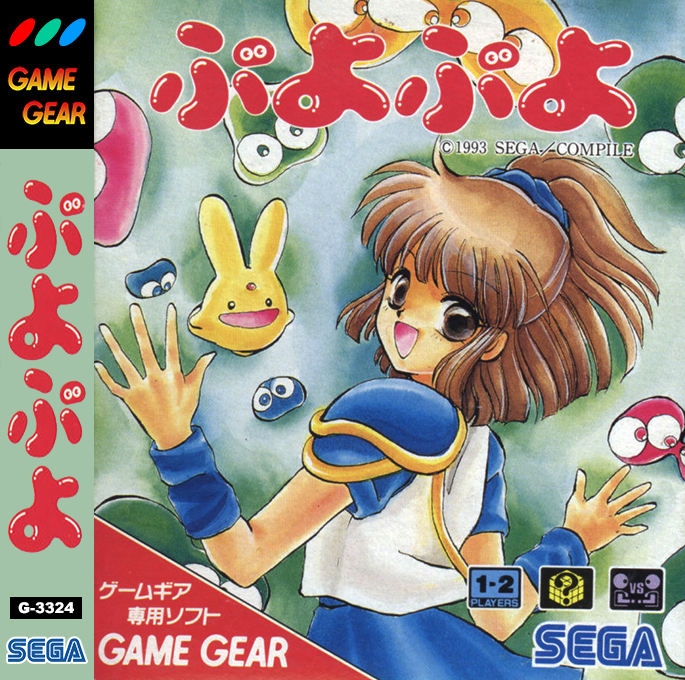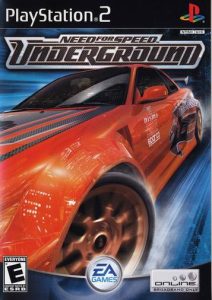Puyo Puyo
Puyo Puyo (ぷよぷよ), previously known as Puyo Pop outside Japan, is a series of tile-matching video games created by Compile. Sega has owned the franchise since 1998, with games after 2001 being developed by Sonic Team.
Puyo Puyo was created as a spin-off franchise to Madō Monogatari (Sorcery Saga), a series of first-person dungeon crawler role-playing games by Compile from which the Puyo Puyo characters originated. The series has sold over 9 million copies, including the Madō Monogatari games.
Gameplay – Puyo Puyo
Generally, the objective of Puyo Puyo games is to defeat the opponent by causing the third column from the left of their side of the screen to become filled with Puyo. Puyo are round, slime-like creatures that, in most variations of the game, fall from the top of the screen in groups of two, three, and four. The pieces can be moved, dropped, and rotated as they fall.
The piece falls until it reaches another Puyo or the bottom of the screen.[1] When four or more Puyo of the same color line up adjacent to each other, the Puyo will connect to each other, “Pop”, and disappear. Puyo of the same color can connect horizontally or vertically, but not diagonally.[1]
The Puyo above those that are cleared fall onto other pieces or the bottom of the screen. Simultaneous Pops (同時消し, simultaneous erasing) are created when more than one group is formed at a time.[1]
A Chain is made when falling Puyo cause a new group of Puyo to Pop, making a chain reaction. When a Chain is achieved, Garbage Puyo, or Ojama Puyo (お邪魔ぷよ, hindrance Puyo) are sent to either clog the opponent’s screen or to cancel out (offset, 相殺) the Garbage Puyo sent by the opponent. Garbage Puyo are translucent pieces that disappear when Puyo are popped next to them.
If multiple groups of Puyo are cleared in succession due to a chain, the amount of Garbage Puyo will increase based solely on the number of steps in the chain. Garbage Puyo are cached above the opponent’s playing field, and do not fall until the attacker’s chain concludes, and then the defender puts down a piece. Garbage Puyo block the opponents’ playing fields, and can cause them to lose if one is placed the third spot from the left in the top row.[1]
Compile games – Puyo Puyo

The first Puyo Puyo game was developed by Compile and released in 1991 for the MSX2 and Family Computer Disk System; the latter release was published by Tokuma Shoten as a pack-in for their Famimaga magazine. The puzzle game features characters from the 1990 role-playing video game Madō Monogatari 1-2-3, also developed by Compile.
The game includes “Endless” mode, where the player attempts to amass a large score, “Mission” mode, where the player is given a pre-configured board and must attempt to satisfy conditions, and a two-player competitive mode.[2]
Compile and Sega collaborated to create an arcade version of Puyo Puyo. It was released in October 1992 for Sega’s System C2 hardware.[2] Unlike the previous release, the game focuses on competitive play; the single-player mode consists of a gauntlet consisting of either 3, 10, or 13 computer opponents, while the multiplayer mode allows two human players to battle each other. The game was ported to several major platforms in Japan, with the Mega Drive becoming a bestseller.[3]
The game was followed by Puyo Puyo 2 in September 1994, also released for Sega System C2.[4] Puyo Puyo 2 adds the ability to counter the opponent’s chains; additionally, it changes the single-player gauntlet from a linear structure to a roulette-based structure that requires the player to pass certain score thresholds to advance.
Like its predecessor, Puyo Puyo 2 was released on a variety of home platforms. In 2004, it was included in the Sega Ages 2500 line of PlayStation 2 games.[5]
Puyo Puyo Sun, released in 1996 for the Sega Titan Video arcade hardware, adds a “Sun Puyo” mechanic that allows the player to send extra garbage to opponents. Puyo Puyo~n, released in 1999 for the Dreamcast, adds character-specific powers that assist the player in clearing Puyo.
Compile’s final Puyo Puyo game, Puyo Puyo Box, includes ports of the first two arcade games alongside original content.[1]
Compile released a variety of spin-off titles on home consoles, handhelds, and through their Disc Station disk magazine. The Nazo Puyo series expands on the original Puyo Puyo‘s Mission mode, with the Nazo Puyo: Arle no Roux for Game Gear in 1994, Super Nazo Puyo: Rulue no Roux for Super Famicom in 1995 and Super Nazo Puyo 2: Rulue no Tetsuwan Hanjōki for Super Famicom in 1996 introducing role-playing elements. Other notable spin-offs include the roguelike Wakuwaku Puyo Puyo Dungeon (1998, Sega Saturn and PlayStation), Puyo Puyo Da! dancing game (1998, arcade and Dreamcast), and Arle no Bōken: Mahō no Jewel monster-collecting role-playing game (2000, Game Boy Color).[6]
International releases – Puyo Puyo
The 1992 arcade Puyo Puyo was translated to English with character name changes and minor visual changes to Harpy, renamed Dark Elf, character’s skit. Sega added this version into their Sega Ages port on Nintendo Switch.[15]
Instead of directly translating the Mega Drive version of the 1992 arcade game, Sega decided to replace the Madou Monogatari cast with villains from the Adventures of Sonic the Hedgehog animated television series.
The resulting game, Dr. Robotnik’s Mean Bean Machine, was released in 1993, along with a Game Gear version adapted from Nazo Puyo. Nintendo followed suit in 1995, modifying Super Puyo Puyo into Kirby’s Avalanche (Kirby’s Ghost Trap in Europe), featuring Kirby characters. Spectrum HoloByte also released a Puyo Puyo title for Microsoft Windows 3.1 and the Macintosh in August 1995, under the name Qwirks.[16]
The next localized release was in 1999, when the Neo Geo Pocket Color port of Puyo Puyo 2 was released in English as Puyo Pop. Unlike the arcade translation, most characters kept their original names; only the character Satan retained his English arcade title of the Dark Prince.[citation needed]
After the Game Boy Advance Puyo Pop, Puyo Pop Fever saw a worldwide release, with North America receiving the GameCube and Nintendo DS versions and Europe receiving it on the majority of platforms it came out on.[citation needed] Finally, the Mega Drive version of Puyo Puyo 2 was released, untranslated, on the Wii‘s Virtual Console as an import title and the arcade version of Puyo Puyo 2 is included in Sega 3D Classics Collection.[citation needed] Also the N-Gage Puyo Pop was released worldwide in 2003.[citation needed]
As the game Hatsune Miku: Project Mirai Deluxe/DX was released worldwide, consequently also its Puyo Puyo mini-game saw release outside Japan. Sonic Runners ran a collaboration event with Puyo Puyo!! Quest in July 2015.[citation needed]
Puyo Puyo Tetris was released overseas on the Nintendo Switch and the PlayStation 4 in Q2 2017.[17] This marks the first time a localized Puyo Puyo game was marketed overseas under its original name.
Other releases – Puyo Puyo
The 1995 video game Timon & Pumbaa’s Jungle Games, developed by 7th Level and published by Disney Interactive for Microsoft Windows and Mac OS, features a variation of Puyo Puyo titled Bug Drop, in which Puyos are replaced by bugs.[18] This version was also released separately as Timon & Pumbaa’s Bug Drop in 1998 as part of Disney’s Hot Shot series of PC games.
2003’s Billy Hatcher and the Giant Egg features an unlockable Puyo Pop minigame, which requires the use of the GameCube – Game Boy Advance link cable to download the minigame to a Game Boy Advance.[19]
In July 2005, Bandai released Kidou Gekidan Haro Ichiza: Haro no Puyo Puyo (機動劇団はろ一座 ハロのぷよぷよ) (lit. “Mobile Theatrical Company Haro: Haro‘s Puyo Puyo”) in Japan for the GBA.[20] It is based on the Mobile Suit Gundam anime series and presented in the style of the SD Gundam series. In this game, Puyo are replaced by Gundam’s mascot, Haro.
Rin Hoshizora of the anime Love Live! served as the new star of the Puyo Puyo games, though it is unknown if this is to be a one-time spin-off (similar to Haro no Puyo Puyo) or a part of the main series.[21]
A new mobile game, Puyo!! Touch, was released for iOS and Android devices on November 26, 2015,[22] but the service was shutdown on November 30, 2016, citing lackluster performance in the market.[23]
A free-to-play version, Puyo Puyo VS, was released for Microsoft Windows and focuses on multiplayer battles.[24]
Sonic Mania (2017) contains a Puyo Puyo minigame as a boss battle in the Chemical Plant Zone and as an unlockable mode, directly referencing Dr. Robotnik’s Mean Bean Machine. Director Christian Whitehead considered it the most “complex” boss fight for them to develop.[25][26]
Puyo Puyo is playable via in-game arcade machines in Yakuza 6 and the PlayStation 4 version of Judgment.[27]
Development – Puyo Puyo
Puyo Puyo was originally conceived by Compile employee and Sting Entertainment founder Kazunari Yonemitsu. Yonemitsu felt that the puzzle games at the time had “weak” characters and thus decided to create a puzzle game using characters from Compile’s Madou Monogatari RPG series. The success of Street Fighter II influenced Puyo Puyo‘s focus on competitive gameplay, with Yonemitsu trying out many mechanics in an attempt to recapture the fighting game’s competitive nature.[28]
In March 1998, Sega obtained the rights to the Puyo Puyo series and its characters from Compile, while Compile continued to develop and publish Puyo Puyo games, even on platforms that Sega was competing against. These games include Sega in their copyright information.[29][30][31]
Prior to assuming full development duties for the franchise, Sega ported Puyo Puyo 2 to the WonderSwan.

Baroque
Cooking
Theme
Warning
Memories











